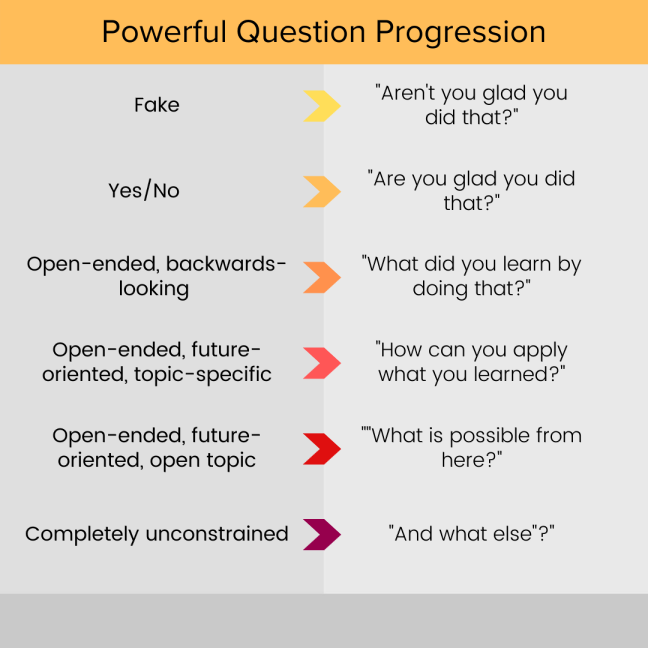Coach Like a Pro
/As a leader, one of the most effective ways to grow your people is to coach them. Letting them grapple with a problem and find their own answers — rather than telling them what to do — helps them learn at a deeper level and builds their expertise and confidence.
And the two most important coaching tools at your disposal are a well-tuned mindset and powerful questions.
Your mindset
As a coach, you want the other person to think creatively and freely. People can tell if you have an opinion, judgement, or viewpoint — and might try to give you what they think you’re looking for, get defensive, or even disengage. Entering into the conversation with a neutral and curious mindset will show the other person that you are open to hearing what they have to say. This means setting aside your own agenda for how a solution should be reached, allowing for exploration without judgement, and being truly curious about the other person’s ideas, perspectives, and motivations.
Of course, during the conversation you will notice that your opinions and expertise do enter your mind; you solve problems all day long and that part of your brain won’t just politely disappear because you happen to be in a coaching moment. So it’s your job to notice your inner advice-giver and put it aside. Come up with a phrase you can say, such as, “Oh hello, problem-solving idea. I don’t need you right now so I will get back to being a coach.”
Not all questions are created equal
Another practice you will want to add to your coaching toolbox is powerful questions. When you ask someone a question, their brain goes in search of an answer. And the direction and depth of their search depends on the type of question you ask. You want the other person to be as thoughtful and imaginative as possible during your coaching inquiry.
First let’s start by looking at unpowerful questions. These come in a variety of forms:
The Fake Question. This is your opinion with a question mark at the end. E.g. “Aren’t you glad you did that?” really means you’re glad they did that and you want them to agree with you.
The Leading Question. This is your recommendation framed as a question. E.g. “What if you tried…?” is just your advice to try a certain solution.
The Yes/No Question. These are real questions and aren’t bad per se, but they don’t elicit much thought or discovery. You will get very little information from a yes/no question.
Powerful questions, on the other hand, allow for deeper, more thoughtful reflection. Their most important features are that they are open-ended and future-oriented.
Look at how we can evolve a question from something unhelpful to something that produces insight and possibility:
So instead of asking a question that’s not even a question, you could ask a clear yes/no question
Better yet, instead of a yes/no question, ask an open-ended question
To help the person look forward, ask a future-oriented question
To open up further options, ask about general possibilities
And finally, ask a completely unconstrained question to uncover any other ideas the other person may have
To become a better coach, practice asking powerful questions. Combined with a neutral and curious mindset, you’ll be eliciting insights and ideas in no time.
© Jennine Heller and J Heller Coaching. Unauthorized use and/or duplication of this material without express and written permission from this blog’s author and/or owner is strictly prohibited. Excerpts and links may be used, provided that full and clear credit is given to Jennine Heller and J Heller Coaching with appropriate and specific direction to the original content. • Photo credit: Tirachard Kumtanom from Pexels
Want these articles delivered directly to your inbox? Join the list!





